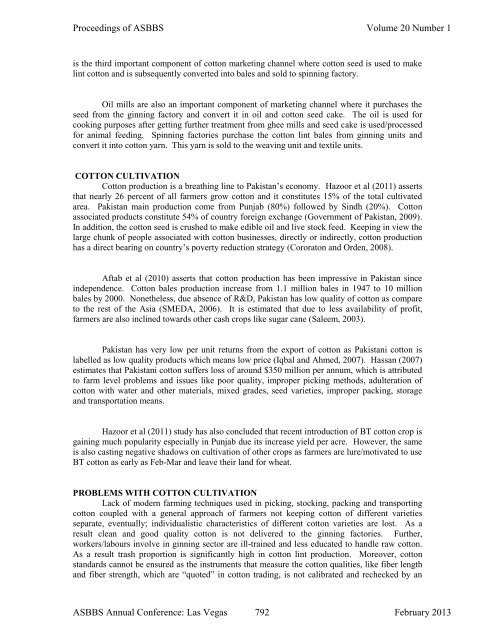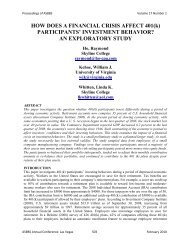Muhammad, Imran; Nadeem, Kureshi & Akmal, Attaullah - Asbbs.org
Muhammad, Imran; Nadeem, Kureshi & Akmal, Attaullah - Asbbs.org
Muhammad, Imran; Nadeem, Kureshi & Akmal, Attaullah - Asbbs.org
- No tags were found...
Create successful ePaper yourself
Turn your PDF publications into a flip-book with our unique Google optimized e-Paper software.
Proceedings of ASBBS Volume 20 Number 1is the third important component of cotton marketing channel where cotton seed is used to makelint cotton and is subsequently converted into bales and sold to spinning factory.Oil mills are also an important component of marketing channel where it purchases theseed from the ginning factory and convert it in oil and cotton seed cake. The oil is used forcooking purposes after getting further treatment from ghee mills and seed cake is used/processedfor animal feeding. Spinning factories purchase the cotton lint bales from ginning units andconvert it into cotton yarn. This yarn is sold to the weaving unit and textile units.COTTON CULTIVATIONCotton production is a breathing line to Pakistan’s economy. Hazoor et al (2011) assertsthat nearly 26 percent of all farmers grow cotton and it constitutes 15% of the total cultivatedarea. Pakistan main production come from Punjab (80%) followed by Sindh (20%). Cottonassociated products constitute 54% of country foreign exchange (Government of Pakistan, 2009).In addition, the cotton seed is crushed to make edible oil and live stock feed. Keeping in view thelarge chunk of people associated with cotton businesses, directly or indirectly, cotton productionhas a direct bearing on country’s poverty reduction strategy (Cororaton and Orden, 2008).Aftab et al (2010) asserts that cotton production has been impressive in Pakistan sinceindependence. Cotton bales production increase from 1.1 million bales in 1947 to 10 millionbales by 2000. Nonetheless, due absence of R&D, Pakistan has low quality of cotton as compareto the rest of the Asia (SMEDA, 2006). It is estimated that due to less availability of profit,farmers are also inclined towards other cash crops like sugar cane (Saleem, 2003).Pakistan has very low per unit returns from the export of cotton as Pakistani cotton islabelled as low quality products which means low price (Iqbal and Ahmed, 2007). Hassan (2007)estimates that Pakistani cotton suffers loss of around $350 million per annum, which is attributedto farm level problems and issues like poor quality, improper picking methods, adulteration ofcotton with water and other materials, mixed grades, seed varieties, improper packing, storageand transportation means.Hazoor et al (2011) study has also concluded that recent introduction of BT cotton crop isgaining much popularity especially in Punjab due its increase yield per acre. However, the sameis also casting negative shadows on cultivation of other crops as farmers are lure/motivated to useBT cotton as early as Feb-Mar and leave their land for wheat.PROBLEMS WITH COTTON CULTIVATIONLack of modern farming techniques used in picking, stocking, packing and transportingcotton coupled with a general approach of farmers not keeping cotton of different varietiesseparate, eventually; individualistic characteristics of different cotton varieties are lost. As aresult clean and good quality cotton is not delivered to the ginning factories. Further,workers/labours involve in ginning sector are ill-trained and less educated to handle raw cotton.As a result trash proportion is significantly high in cotton lint production. Moreover, cottonstandards cannot be ensured as the instruments that measure the cotton qualities, like fiber lengthand fiber strength, which are “quoted” in cotton trading, is not calibrated and rechecked by anASBBS Annual Conference: Las Vegas 792 February 2013
















